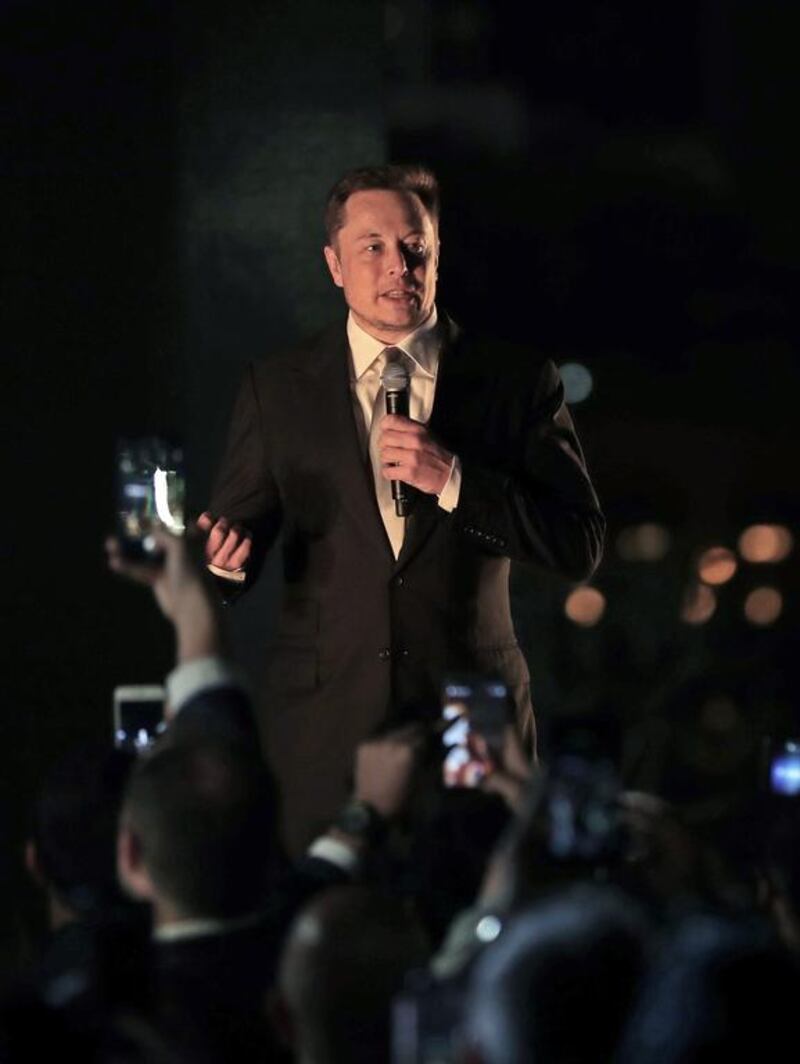It is not an entirely original observation that Elon Musk is less like the inventor after whom he named his car company than he is like that man’s great rival and opposite, but it is an observation reinforced by Mr Musk’s recent visit to Dubai.
Mr Musk came to Dubai to do some business and build market share for his Tesla, which bears the name of the stunningly brilliant and slightly mad scientist Nikola Tesla, whose destiny it was to die alone and broke in a New York hotel room, while the business-minded Thomas Edison was feted even after death as “the wizard of Menlo Park”.
Mr Musk himself acknowledged, in a 2008 interview, that he is more of an Edison man.
This is not just a matter of picking sides in a Rorschach test for nerds; it is a useful insight into the mindset of someone who aspires to change the world, including those parts of it located in the UAE.
In that interview nine years ago, conducted under the auspices of the Henry Ford Museum, Mr Musk said Edison was “probably one of the biggest role models” for him, and that he had read books on Edison’s life.
“The car company is called Tesla,” Mr Musk said. “And the reason it’s called Tesla is because we use an AC induction motor, which is an architecture that Tesla developed. And the guy probably deserves a little more play than he gets in current society. But on balance, I’m a bigger fan of Edison than Tesla because Edison brought his stuff to market and made those inventions accessible to the world, whereas Tesla didn’t really do that.”
This underscores Mr Musk's visit to Dubai. In a way it is a modern-day parallel to the 19th-century "war of the currents" between the AC (alternating current) system that Tesla helped create, and the DC (direct current) system that emerged from Edison's workshops. That battle was decided by infrastructure and publicity — perhaps offering a template in Mr Musk's mind for the current fight between electric vehicles and petrol vehicles (and, in an undercard bout, between electric vehicles and hydrogen fuel cell vehicles).
While AC is more efficient than DC, just as electricity is more efficient than petrol, its victory was not at all assured. Edison rolled out a network of transformer stations in an attempt to corner the market (infrastructure). Edison also conducted a savage campaign against AC, damning it as a threat to the public and sponsoring its use in public displays of the electrocution of animals, including dogs and a lame horse (publicity).
The reason AC won the day is not because of Tesla and his induction motor; it’s because his science had found a patron in George Westinghouse, who had the toughness and craftiness to hit back against Edison in the public and political arenas.
Mr Musk courts the powerful so that they are invested, financially and otherwise, in his projects.
In the early days of Tesla the company, when it was still a fledgling but able to position itself as the harbinger of a newer and clearer economy, managed to secure a $465 million loan from the US energy department.
During Mr Musk’s visit to the UAE, he met Sheikh Mohammed bin Rashid, Vice President and Ruler of Dubai, on the same day as the industrialist announced that his company was up and running in the emirate.
At the same time the agency Dubai FDI, which is part of the emirate’s Department of Economic Development, hitched its wagon to Mr Musk’s car. “Dubai FDI will continue to assist Tesla to expand and grow in the region and its neighbourhood,” said the agency’s chief, Fahad Al Gergawi.
Abu Dhabi's Adnoc has combined with Tesla to run a survey on the feasibility of having chargers at service stations.
One suspects that these alliances will help Tesla as it seeks to build a network of charging stations across the country and indeed the region. While in Dubai, Mr Musk said there will be enough charging stations that people will be able to drive one of his cars "anywhere in the GCC" by 2018. This fits into a master plan "to build a global network of charging stations" that dates back at least five years, according to Ashlee Vance's biography of Mr Musk (very good book, by the way).
Mr Musk seeks out publicity not because he is an egomaniac, but because he understands its value. He was a loner as a child and, as per Vance’s book, even today “can come off as shy and borderline awkward.”
In the end, the divide between Tesla fans and Edison fans is a divide between the desire for purity and the acknowledgement of practicality. And yet Mr Musk does have some Tesla in his bones.
First, he seems to do most of his engineering in his head — as a boy he would drift into long trances as he thoughts. That is how Tesla’s brain was wired too.
Second there is his otherworldliness, which reaches far beyond the practical. He really does want to save the people of Earth. He really does want to build colonies on Mars for the good of mankind (thus his SpaceX project). His greater goal is nothing less than “becoming a multiplanetary species with a self-sustaining civilisation on another planet”.
This is a case not of Mr Musk being Tesla or Edison, one man or the other; it is a case of thesis plus antithesis equals synthesis.
rmckenzie@thenational.ae
Follow The National's Business section on Twitter





